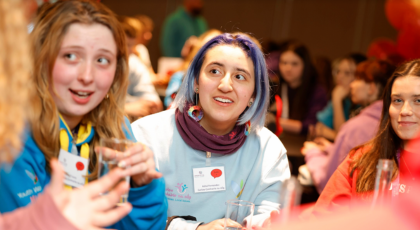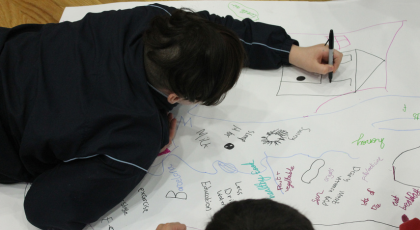Young people’s involvement in the development of a programme for
school leavers
1. How the topic was identified
- The topic was identified by two youth workers, based on interactions with young people facing the transition from second-level education.
- The Youth Advocate provides career guidance to young people across County Clare.
- The Youth Information Team in Clare Youth Service runs programmes, talks and presentations on the topic but the uptake was inconsistent. However, during outreach sessions with youth workers, young people regularly expressed concern and stress about the transition they faced.
- The youth workers decided to consult young people facing this transition to ensure that the programmes on offer matched their needs.
- They developed a consultation methodology with a pilot group of young people, with a view to conducting consultations more widely once the methodology was completed.
2. The young people’s participation in the decision-making
- The key decision-makers in the Youth Service are the management team, Chief Executive Officer and the Board of Directors.
- Other key decision-makers include the Youth Information Team, the Youth Advocate, other Youth Service staff, Community Training Centre Management, Youthreach Centres, Principals, Guidance Counsellors and other local education partners.
- The young people in the pilot group and the consultation group were also important decision-makers.
3. How the views of young people were sought, and how they affected the decisions
Space
- All young people involved in both the pilot group and the consultation group were either experiencing the transition from second-level to further study/work or facing it in the coming year.
- The pilot group consisted of four young people (two girls and two boys) in Year 2 of the Leaving Certificate Applied Programme, aged between 16 and 19. They were attending the Community Training Centre, a supported educational setting for young people at risk of leaving education early.
- The consultation group included 15 young people (aged 17 to 21) on a Work Experience Programme.
- Both groups included young people whose voices have been seldom heard, and who experienced difficulties in mainstream education and in approaching the transition by themselves.
- All the young people consulted were at risk of leaving school early or not following through with further education/work placements. There was a mix of young people from urban and rural areas.
- The consultation was in a comfortable room with adequate heat and seating.
- The consultation was held at a time and venue that suited the participants.
- There was an atmosphere of mutual respect with a strong emphasis on communication in a safe space.
- The topic was relevant to them: the young people in the pilot group were facing the transition from second-level school and those in the consultation group had already started that transition, having left school and entered a supported work placement initiative.
- Opportunities were provided for the young people to take part in smaller groups and to vote using non-verbal methods if they did not want to speak in a large group.
- The facilitators were aware of the literacy levels of the young people, and were able to ensure that the activities suited needs of the group.
Voice
- The purpose of the consultation, the choice of methods and how those methods were decided was clearly explained to the young people.
- They were informed that participation was voluntary and arrangements were made for any young person who did not wish to take part.
- A range of methods were used with the pilot and the consultation groups to maximise participation opportunities for everyone.
- Young people from the pilot group were involved in choosing the topic, questions and methods.
- The pilot group used a timeline method to map out all the decisions, challenges and opportunities that moving on from second-level brings and to choose the issues to be included in a programme for young people leaving school.
- Based on feedback from the pilot group, the consultation group used the timeline method to focus their thoughts and then worked in small groups to map out the decisions, challenges and opportunities they felt moving on from second-level
education would bring them. - An open space method was used for young people to choose and categorise the things they wanted in a programme for leaving school.
- A world café method allowed young people to share their ideas on each category using a jotter page method.
- Finally using sticky dots, the young people voted on their top two issues in each category.
- Their top choices formed the basis for the objectives/learning outcomes for the Youth Information Leaving School Programme. These were shared with the strategic partners to inform their programme planning and needs assessments.
Audience
- The young people were informed about who would see the findings of the consultation.
- The facilitator’s role was explained, and the young people were told what would happen with the findings of the consultation.
- The young people’s views and opinions were compiled into a poster that was shared with relevant people (Youthreach Centres/Principals/Guidance Counsellors).
- Young people were informed that their views would be used by the Youth Information Team to develop a Leaving School Programme for 2020.
- The young people were informed that their views and opinions would be shared with Clare Youth Service Management, the Chief Executive Officer and the Board of Directors (who have overall say in the programmes run by Clare Youth Service).
Influence
- The young people were told when to expect feedback from the consultation.
- The young people’s views and opinions were taken seriously by the Youth Information Team and were used to develop the new Leaving School Programme.
- The young people were informed that the new programme would mention their contribution.
- Facilitated by the Youth Advocate, the young people’s views and opinions were discussed by the Community Training Centre and Youthreach staff following the consultation.
- After the consultation, the management team and Chief Executive Officer examined the document and gave the young people feedback.
- The young people evaluated the consultation process.
4. The key findings of the consultation
The concerns and needs of this target group are wide, varied and yet consistent with other evidence we have encountered in more informal settings. Below are the top issues young people would like addressed by a preparation programme for school leavers.
- Accommodation
• Rent allowance and entitlements - Education
• Choosing the right college/PLC course
• How to apply for travel allowances - Working
• What are my rights? (holidays/wages/sick leave) - Life skills
• How to be a responsible parent
• How to quit smoking - Supports
• Where to get help generally
• Rights - Budgeting
• How to get a mortgage or how to pay other
monthly bills like insurance
• How to keep a record of funds - Being given a voice about their experiences
• Space to talk about their experiences rather than
just receiving information or guidance
5. Lessons learned
- It would have worked better if, from the start of the year, time had been allocated in the work plans of the Youth Information Team and the Youth Advocate for cross-team consultations with young people.
• We learned from the pilot group that one of the methods used did not adequately capture the young people’s views.
• If Covid-19 had not happened we would have been able to complete this project more quickly.
6. Subsequent developments
- A logic model for the content of the Leaving School Programme has been developed.
- Session guidelines and a PowerPoint presentation to be used during the programme have been developed.
- These guidelines have been reviewed in two sessions by Leaving Certificate Applied students.
- Plans have been made for a group of young people to work with the Youth Information Team on developing a booklet to accompany the programme.


